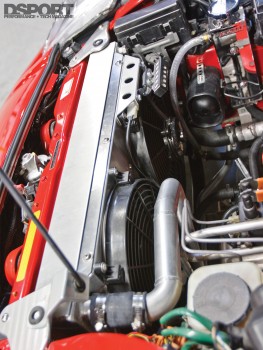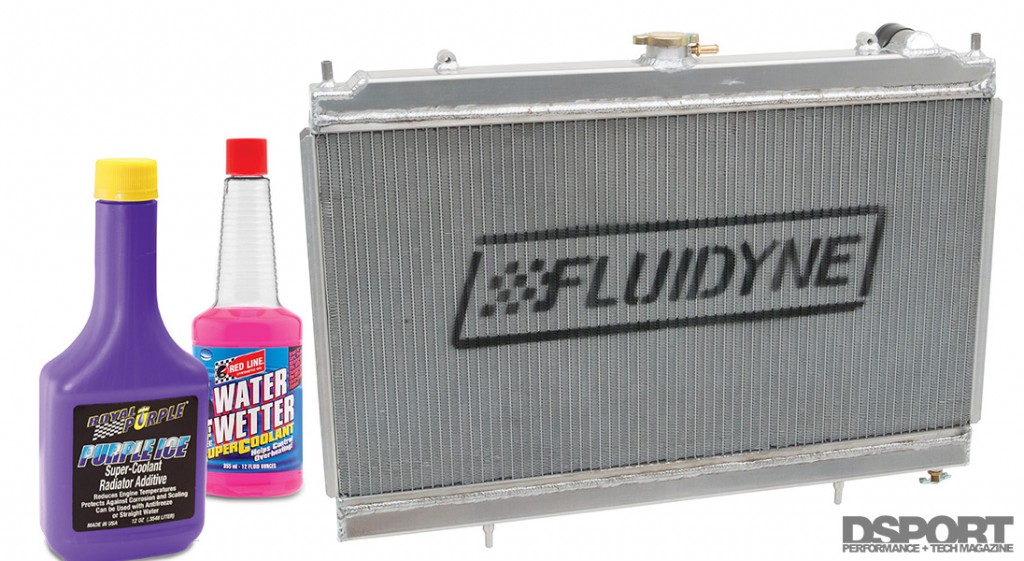Maximizing Radiator Performance
To maximize the efficiency from your radiator, you need to maximize the airflow across its core. If your car is equipped with an engine-driven cooling fan, make sure that you keep the radiator shroud in place. The radiator shroud allows the cooling fan to pull the air directly through the radiators core. If your vehicle is equipped with an electric fan, you may or may not be able to upgrade the OEM fan with a single or dual high-performance electric fan(s). Make sure that you wire up these replacement fans for correct operation (push in front of radiator, pull when mounted in back of radiator). If the electric fans do not have a positive seal to the radiator core, weatherstripping can be used to create an air-tight seal. Finally, choosing the best coolant mix will allow you to optimize the performance from your aftermarket performance radiator.
Boiling Point, Pressure and Coolant
For a cooling system to reject the most waste heat from the engine, the coolant must remain in a liquid form, instead of boiling to a vapor state. As a result, maximizing the boiling point of the coolant used is a consideration. Fortunately, modern cooling systems take this into account.
A few things that you may remember from your high- school chemistry class are the physical properties of water. Pure water boils at 100 degrees Centigrade (212 degrees Fahrenheit) and it freezes at 0 degrees Centigrade (32 degrees Fahrenheit). These phase changes occur under normal atmospheric conditions. When water is placed under pressure, it has a harder time making the state change from a liquid to vapor. When under pressure, it takes additional heat to get the water boiling. At 14.7psi (~1 bar) above atmospheric pressure, water boils at 250 degrees Fahrenheit (121 degrees Celsius).
When you install an aftermarket 1.3 bar (18.9 psi) radiator cap, the boiling point for pure water in your cooling system is raised to 256 degrees Fahrenheit (124 degrees Celsius). In addition to pressurizing the cooling system, changing the coolant from pure distilled water to a mixture of water and an ethylene glycol solution can provide additional anti-boiling protection. However, boiling protection is not the only consideration in choosing your coolant mix for your application.
 OEMs usually ship their vehicles with a coolant that’s part distilled (or demineralized) water and part “antifreeze.” Today’s antifreeze is generally an ethylene-glycol based fluid that has been treated with additional chemicals to inhibit rust and provide lubrication to the engine’s water pump. Ethylene Glycol solutions have both advantages and disadvantages compared to pure water when used in a cooling system. As previously mentioned, filling 33% or 50% of your cooling system with ethylene glycol will help to raise the boiling point over a pure-water solution. A 33% solution will provide about a 7 degree Fahrenheit (4 degree Celsius) increase in boiling temperature. A 50% solution (a.k.a. 50/50 solution) will raise the boiling point by about 15 degrees Fahrenheit (9 degree Celsius). That’s the good news. The bad news about ethylene glycol/water mixtures is that the solutions specific heat capacity is less than pure water. That same 50% mixture will have a specific heat capacity that is about 20-percent less than pure water. That means as a quart of the 50/50 passes through the cooling system it is only able to carry away 80 percent of the heat from the cylinders that pure water would be able to transfer. In a high-performance application, the desire is to maximize the waste heat transfer through the cooling system. As a result, pure water is generally teamed with a rust inhibitor additive and sometimes a cooling system booster that reduces the surface tension of the coolant. Some of the more popular boosters are available from Royal Purple (Purple Ice), RedLine (Water Wetter), and DEI (Radiator Relief).
OEMs usually ship their vehicles with a coolant that’s part distilled (or demineralized) water and part “antifreeze.” Today’s antifreeze is generally an ethylene-glycol based fluid that has been treated with additional chemicals to inhibit rust and provide lubrication to the engine’s water pump. Ethylene Glycol solutions have both advantages and disadvantages compared to pure water when used in a cooling system. As previously mentioned, filling 33% or 50% of your cooling system with ethylene glycol will help to raise the boiling point over a pure-water solution. A 33% solution will provide about a 7 degree Fahrenheit (4 degree Celsius) increase in boiling temperature. A 50% solution (a.k.a. 50/50 solution) will raise the boiling point by about 15 degrees Fahrenheit (9 degree Celsius). That’s the good news. The bad news about ethylene glycol/water mixtures is that the solutions specific heat capacity is less than pure water. That same 50% mixture will have a specific heat capacity that is about 20-percent less than pure water. That means as a quart of the 50/50 passes through the cooling system it is only able to carry away 80 percent of the heat from the cylinders that pure water would be able to transfer. In a high-performance application, the desire is to maximize the waste heat transfer through the cooling system. As a result, pure water is generally teamed with a rust inhibitor additive and sometimes a cooling system booster that reduces the surface tension of the coolant. Some of the more popular boosters are available from Royal Purple (Purple Ice), RedLine (Water Wetter), and DEI (Radiator Relief).
Antifreeze is as an “anti-freezing” agent. The biggest advantage of ethylene- glycol solutions for cooling systems is the reduction in the freezing temperature of the coolant. When pure water freezes it actually grows about eight percent in volume. If you had your vehicle’s cooling system completely filled with pure water and the temperature becomes cold enough to cause all of the water to freeze, it’s quite likely that significant damage would occur to the engine block. The addition of ethylene-glycol antifreeze can significantly lower the freezing temperature of the coolant. A 33% solution will reduce the freezing temperature from 32 degrees to about 3 degrees Fahrenheit (-16 degrees Celsius). A 50/50 mix will drop the freezing point to – 34.6 degrees Fahrenheit (-37 degrees Celsius).
[pullquote]OVERHEATING CAN LEAD TO A MULTITUDE OF AILMENTS INCLUDING WARPED CYLINDER HEADS, WARPED BLOCKS AND HEAD-GASKET FAILURES[/pullquote]So what should you fill your cooling system with? If you are planning to drive your vehicle year round, you need to determine the lowest temperature that you expect to encounter. If it will encounter freezing, you need to mix in some ethylene-glycol antifreeze to achieve the correct amount of freeze protection. Most antifreeze bottles will come with a chart that shows the percent mixture and freeze protection. Follow these guidelines to add the minimum amount of ethylene-glycol and only use demineralized or distilled water to fill up the rest of the system. It’s always a good idea to add a rust inhibitor whenever less than 50-percent ethylene glycol is added. Do not use tap or drinking water as the minerals in the water can corrode the coolant passages and cause scale buildup. We’ve seen great results with both Radiator Relief and Purple Ice as additives. We highly recommend either as an additive. Be sure to cap off your cooling system with the highest pressure cap that you can find.
 Upgrading each of your cooling system’s components can add longevity to your engine and help maximize power output
Upgrading each of your cooling system’s components can add longevity to your engine and help maximize power output
The Bottom Line
Failure to upgrade an engine’s cooling system after significant performance gains are made can lead to overheating. Overheating can lead to a multitude of ailments including warped cylinder heads, warped blocks and head-gasket failures. A high-quality, high-performance radiator can help to keep your engine intact. Combining quality components in your engine’s cooling system with proper service will help to maximize the reliability of your engine. Keep it cool.


